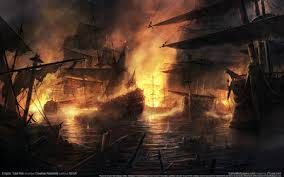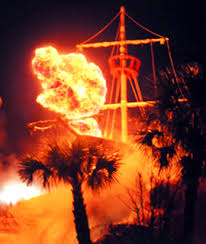

“Casabianca” by Felicia Hemans tells the story of the thirteen-year-old boy Casabianca who was the son of an admiral on a ship during the Battle of the Nile. Ultimately, Casabianca perishes “in the explosion of the vessel, when the flames [have] reached the powder.” (Notes) In the poem Hemans uses language that glorifies Casabianca’s role, invoking language often used to describe kings and other great heroes and portraying the boy as “born to rule the storm;/ A creature of heroic blood, / A proud, though childlike form” and again as “the gallant child.” She ends the poem by describing his heart as “the noblest thing which perished there”, transforming Casabianca from just a boy to a hero who stood his ground and never surrendered. The nobility and heroism juxtapose the boy’s age and allow the reader to see loyalty instead of child like obedience in the boy’s dedication to his dead father’s command.
Hemans also personifies the fire though both her use of language and her use of the rhyme scheme. Though no two stanzas repeat the same sets of true rhyme, they are tied together by hints of near rhyme, keeping the stanzas from being completely separated yet still embodying the randomness of fire. The alternation of true rhyme in each stanza, however, with pairs such as deck and wreck, and storm and form create a sense of urgency and speed when the poem is read, mirroring the speed of the flames as they quickly engulf the ship.
The language used to describe the flames matches the tempo of the rhyme scheme of the poem as “the flames rolled” and “wrapt” and “wreathed” through “sail and shroud.” Hemans creates a second, aggressive character out of the flames though it is not explicitly villainous. Though the flames ultimately lead to the boy’s death, they also serve as an emphasis of his heroism in two ways. The flames emphasize his nobility and bravery in facing such a wild and uncontrollable enemy, but they also emphasize his royalty with the imagery they created as they “streamed above the gallant child, / like banners in the sky.” The images used to describe the flames are more similar to the language of a coronation of “the noblest” king than they are to the death of a young boy.
Sources of images:
http://static.desktopnexus.com/wallpapers/44868-bigthumbnail.jpg
http://www.orlandospfx.com/images/PirateFire.jpg
No comments:
Post a Comment